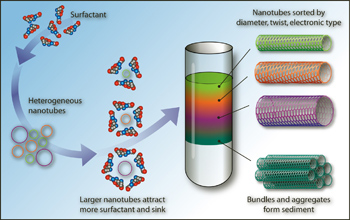Multimedia Gallery
New Method to Sort Carbon Nanotubes
Single-walled carbon nanotubes are coated in soap-like molecules called surfactants, then spun at tens of thousands of rotations per minute in an ultracentrifuge. The resulting density gradient sorts the nanotubes according to diameter, twist and electronic structure.
Current methods for synthesizing carbon nanotubes produce tiny tubes with a variety of diameters and properties which lack consistency and limits their use in commercial technology. Now, NSF-supported researchers at Northwestern University have developed a method to sort carbon nanotubes that vary from each other by no more than 0.02 nanometers (billionths of a meter).
This image accompanied NSF press release, "Researchers Develop Method to Sort Carbon Nanotubes by Size and Electrical Properties."
Credit: Zina Deretsky (adapted from Arnold et al.), National Science Foundation
Images and other media in the National Science Foundation Multimedia Gallery are available for use in print and electronic material by NSF employees, members of the media, university staff, teachers and the general public. All media in the gallery are intended for personal, educational and nonprofit/non-commercial use only.
Images credited to the National Science Foundation, a federal agency, are in the public domain. The images were created by employees of the United States Government as part of their official duties or prepared by contractors as "works for hire" for NSF. You may freely use NSF-credited images and, at your discretion, credit NSF with a "Courtesy: National Science Foundation" notation.
Additional information about general usage can be found in Conditions.
Also Available:
Download the high-resolution JPG version of the image. (628 KB)
Use your mouse to right-click (Mac users may need to Ctrl-click) the link above and choose the option that will save the file or target to your computer.



